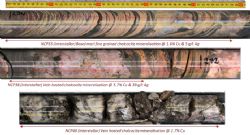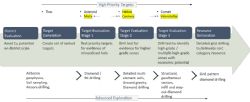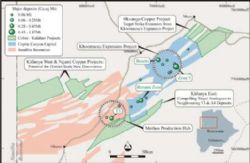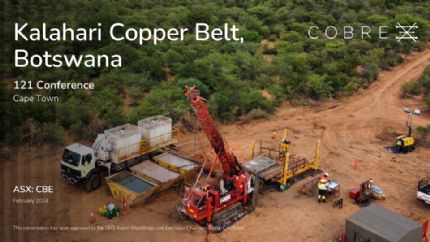 Assays Significantly Extend Cu-Ag Mineralisation in Botswana
Assays Significantly Extend Cu-Ag Mineralisation in Botswana
Sydney, May 16, 2023 AEST (ABN Newswire) - The initial set of assay results from Cobre Limited's ( ASX:CBE) recently completed 5,120m diamond drill campaign at the Ngami Copper Project (NCP) have returned several significant copper-silver (Cu-Ag) intersections into new and developing targets, demonstrating the scale of the mineralised system which appears to be extensively developed on both the southern limb of the anticline opposite the Comet Target and along strike to the northeast of Comet.
ASX:CBE) recently completed 5,120m diamond drill campaign at the Ngami Copper Project (NCP) have returned several significant copper-silver (Cu-Ag) intersections into new and developing targets, demonstrating the scale of the mineralised system which appears to be extensively developed on both the southern limb of the anticline opposite the Comet Target and along strike to the northeast of Comet.
Noting these are wide-spaced exploration holes into new and developing targets, intersection results include:
o NCP40: 26.0m @ 0.4% Cu, including 1.2m @ 1.1% Cu, from 272 to 298m downhole (Interstellar Target);
o NCP38: 9.6m @ 0.6% Cu & 9 g/t Ag, including 0.25m @ 5.7% Cu & 39 g/t Ag, from 263 to 272.6m downhole (Interstellar Target); and
o NCP42: 14.9m @ 0.5% Cu & 13 g/t Ag from 142.5 to 157.4m downhole (Cosmos Target).
Results demonstrate that the anomalous Cu-Ag background mineralisation, on the southern anticline at NCP, extends over a much greater area (several tens of kilometres) than initially anticipated on both limbs.
The extensive strike of anomalous Cu-Ag mineralisation underscores the potential for multiple structurally controlled high-grade zones, including the drill-tested zone at the Comet Target.
The presence of larger structural trap-sites where Cu-Ag mineralisation may be upgraded is further supported by a drill section completed across the Helios Target, which has confirmed the interpretation of extensive macro-parasitic folding of the south limb of the anticline.
Samples for the remainder of the drill programme, including results over the Comet and Asteroid Targets, are currently being processed with results pending.
Commenting on the initial assays results, Chief Executive Officer, Adam Wooldridge, said:
"The first batch of assay results from recent drilling includes data from new targets identified from soil sampling anomalies. The presence of anomalous intersections in several drill holes confirms the extensive scale of coppersilver mineralisation, which exceeds our initial expectations. The results suggest that we may now have several tens of kilometres of prospective strike, where mineralisation may be locally (structurally) concentrated into economic grades rather than isolated targets. The results bear many similarities to the anomalous copper background, size and structural setting of Banana Zone in the north-eastern Kalahari Copper Belt, providing a useful exploration analogue. Our primary focus for follow-up work will be to identify the higher-grade portions of the contact."
Results from the first batch of assay results for the recently completed 5,120m diamond drill programme at NCP have been received. Assaysrelate to drill holes NCP35 through to NCP42 which intersected newly identified targets Interstellar, Helios, Cosmos and Meta with several encouraging Cu-Ag intersections reported. In addition to advancing targets Cosmos and Interstellar, the assay results highlight the extent of the mineralising system at NCP which is significantly larger than initially interpreted, extending over several tens of kilometres on both the northern and southern limbs of the main target anticlinal feature at NCP (Figure 1*).
Of particular interest is the confirmation, through drilling, of a set of large parasitic fold features, originally identified in detailed magnetic data, on the southern limb of the regional anticline at the Helios target. A drill section crossing the target has confirmed that the mineralised contact is doubly folded in this area providing several interesting options for trap-site formation where mineralisation may be upgraded (Figure 2*). The variability in mineralisation along the drill section provides further support for remobilisation of Cu-Ag mineralisation into local structural trap-sites.
At Interstellar, both drill holes NCP38 and NCP40 have intersected vein hosted chalcocite mineralisation as well as fine grained chalcocite above the main redox contact which provides further encouragement for potential highgrade vein dominated mineralisation, typical in several Kalahari Coper Belt (KCB) deposits. Selected core photos of mineralisation are illustrated in (Figure 3*).
Samples for the remainder of the programme, including infill drilling at the Comet Target, are currently being processed at ALS laboratories in Johannesburg Cu-Ag intersections for all the completed assay results for drill holes at NCP are provided in Appendix Jorc Table 2*, with results pertaining to the current announcement highlighted.
NCP Regional Exploration Potential
The drill program at NCP has been designed to intersect sedimentary-hosted, structurally controlled, Cu-Ag mineralisation associated with the redox contact between oxidised Ngwako Pan Formation red beds and overlying reduced marine sedimentary rocks of the D'Kar Formation on the moderate to steeply dipping limbs of a large anticlinal structure which extends across the southern portion of the project area under 50 to 80m of Kalahari Group cover. To date, 52 drill holes, targeted off partial digest low detection limit soil sampling, have intersected the mineralised contact along both limbs of the anticline with the majority of the holes returning anomalous copper intersections for the KCB, demonstrating the prospectivity of the ~80 km of contact associated with the anticline.
The recent assay results highlight the north-eastern portion of the anticline where notable Cu-Ag grades extend over several tens of kilometres on both north and south limbs. As with other portions of the KCB, higher grade structurally controlled deposits are anticipated where mineralisation is locally concentrated to produce economic grades. Of interest, is the nature of the mineralisation, which is dominated by fine-grained chalcocite which offers advantages for beneficiation.
Completion of 3D modelling
A 3D geological model has been created using a combination of lithological and structural data from oriented diamond drill core in Leapfrog software. In addition to modelling, the main stratigraphic contacts and upward coarsening cycles, distinct marker units have also been individually modelled providing information on lateral facies variations which may provide further vectors to higher grade mineralisation. The model also serves as a starting point for future resource modelling. Results are illustrated in Figure 2*.
Exploration approach
Cobre is following a systematic stage-gated exploration approach with a view to evaluating several potential copper districts across the Company's extensive license package, prioritising targets in prospective districts, identifying anomalous Cu-Ag mineralisation in the halo of new deposits, delineating high-grade zones within these anomalous halos and ultimately, resource drilling. The current results highlight this process which has successfully advanced the regional prospectivity of the NCP project as well as progressing both Interstellar and Cosmos Targets to the second and third evaluation stages (Figure 4*).
Target Model
The NCP area is located near the northern margin of the KCB and includes significant strike of sub-cropping Ngwako-Pan / D'Kar Formation contact on which the majority of the known deposits in the KCB occur. The Project is located immediately east of the Kitlanya West (KITW) licenses collectively covering a significant portion of prospective KCB stratigraphy. In terms ofregional prospectivity, the greaterlicense package includes:
- Over 500km of estimated Ngwako Pan / D'Kar Formation contact with several prospective targets located in the KITW and NCP properties.
- Strategic location near the basin margin typically prioritised for sedimentary-hosted copper deposits.
- Outcropping Kgwebe Formation often considered a key vector for deposits in the northeast of the KCB.
- Well defined gravity low anomalies indicative of sub-basin architecture or structural thickening (several deposits in the KCB are hosted on the margins of gravity lows).
- Relatively shallow Kalahari Group cover (between 0m and ~90m thick).
- Numerous soil sample anomalies identified on regional sample traverses.
The Company is targeting analogues to the copper deposits in Khoemacau's Zone 5 development (Figure 5*) in the north-eastern portion of the KCB. These include Zone 5 (92.1 Mt @ 2.2% Cu and 22 g/t Ag), Zeta NE (29 Mt @ 2.0% Cu and 40 g/t Ag), Zone 5N (25.6 Mt @ 2.2% Cu and 38 g/t Ag) and Mango NE (21.1 Mt @ 1.8% Cu and 21 g/t Ag).
*To view tables and figures, please visit:
https://abnnewswire.net/lnk/JHWA02PX
About Cobre Limited
 Cobre Limited (ASX:CBE) is a copper and base-metals explorer with projects in Western Australia and Botswana. The Company recently discovered a new high-grade VMS deposit enriched in Copper, Gold, Zinc and Silver in Western Australia, and is currently exploring approximately 8,100 km2 of tenements within the Kalahari Copper Belt (KCB) in Botswana.
Cobre Limited (ASX:CBE) is a copper and base-metals explorer with projects in Western Australia and Botswana. The Company recently discovered a new high-grade VMS deposit enriched in Copper, Gold, Zinc and Silver in Western Australia, and is currently exploring approximately 8,100 km2 of tenements within the Kalahari Copper Belt (KCB) in Botswana.


![abnnewswire.com]()
Related Companies
Social Media
Share this Article

 ASX:CBE) recently completed 5,120m diamond drill campaign at the Ngami Copper Project (NCP) have returned several significant copper-silver (Cu-Ag) intersections into new and developing targets, demonstrating the scale of the mineralised system which appears to be extensively developed on both the southern limb of the anticline opposite the Comet Target and along strike to the northeast of Comet.
ASX:CBE) recently completed 5,120m diamond drill campaign at the Ngami Copper Project (NCP) have returned several significant copper-silver (Cu-Ag) intersections into new and developing targets, demonstrating the scale of the mineralised system which appears to be extensively developed on both the southern limb of the anticline opposite the Comet Target and along strike to the northeast of Comet.  Cobre Limited (ASX:CBE) is a copper and base-metals explorer with projects in Western Australia and Botswana. The Company recently discovered a new high-grade VMS deposit enriched in Copper, Gold, Zinc and Silver in Western Australia, and is currently exploring approximately 8,100 km2 of tenements within the Kalahari Copper Belt (KCB) in Botswana.
Cobre Limited (ASX:CBE) is a copper and base-metals explorer with projects in Western Australia and Botswana. The Company recently discovered a new high-grade VMS deposit enriched in Copper, Gold, Zinc and Silver in Western Australia, and is currently exploring approximately 8,100 km2 of tenements within the Kalahari Copper Belt (KCB) in Botswana.












